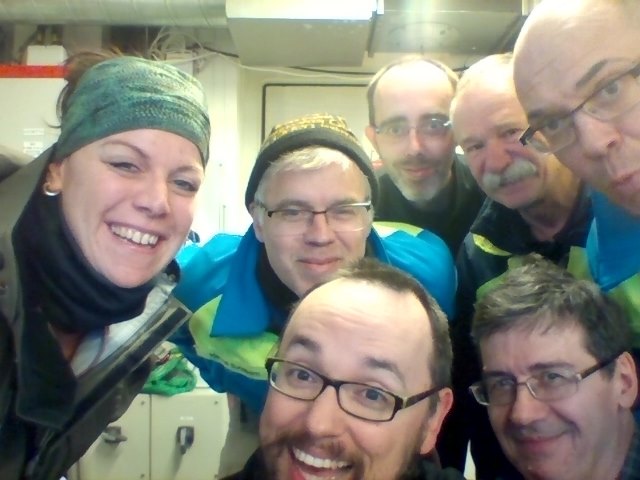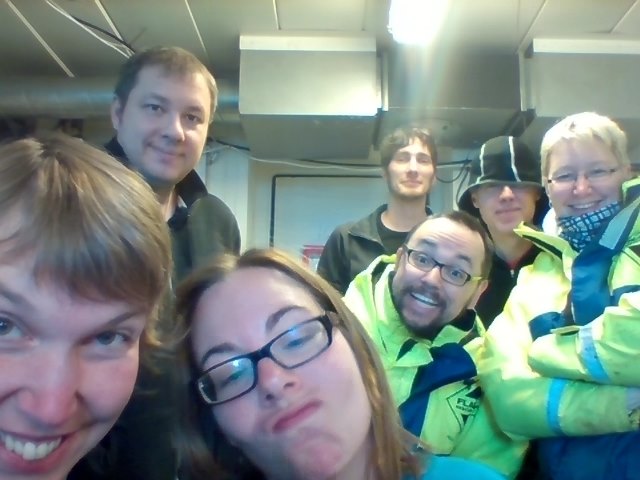August 16
|
|
|
|
| Now we are officially done with the station work. Well, in the end it turned out that the last station I was writing about in this blog was already our last station – so having the small sausage-celebration afterwards was probably a good idea. After that, we had headed to Herald Canyon for geophysical studies, and had planned to also have a large set of CTD stations for water sampling there, but the weather conditions didn’t allow any deployment. We kept trying at different places, but the swell was just too high, so we couldn’t risk putting anything over the reeling. Now we realized in a way how lucky we have been with the weather conditions all along – in respect to putting things into the water, even having multiple deployments simultaneously, and also just in respect to how stable the ship has been all the time. Before this cruise started, most of us were afraid of getting seasick, we have been exchanging stories and videos we have heard or seen from earlier expeditions, different kinds of medications against seasickness had been discussed and brought onboard... and in a way, we totally forgot about this issue – because it was always so stable in the ice. It never felt like being on a moving vessel at all, and all the boxes and pieces of equipment that we had strapped so carefully in the beginning of the expedition had started to become loose. Now it was a different story – still far away from any really dramatic movements or getting even a hint of seasickness, but still: The ship was rolling, swinging; you felt it when lying in your bed, when walking around on the deck and especially in the labs on the higher decks. We got careful again, strapped down our equipment, locked cupboards and didn’t leave computers unsecured on the tables. But this change was not the strangest thing – it was confusing to get out of the shift mode, know that some station action could basically happen any moment, but still it was unclear when. Our methane team had sample bottles prepared for the first station, labelled and ready to be filled, and decksheets ready for 12 stations. We expected a tough time once we got started and weren’t really sure how to prepare – should we sleep to be rested for the station? Should we use the time to get the necessary work on the data done? Maybe it makes sense to stay in a kind of shift mode so that someone is awake for the station, whenever it might be? In the end it was a bit of everything – we slept more than the last weeks, found time to relax, got a lot of work done... and also kind of stayed in the shift mode. Not really, as there was some meetings and discussions during daytime, and it was nice to see “the other half of the people” again, and also to get some “real food” again instead of the endless supply of sandwiches we had been mainly eating at night. On the other hand: we “night people” had been enjoying the quiet hours of working at night, the empty gym or sauna at these hours, the company of each other when meeting for the 3am “lunch”... and the sun. As I might have mentioned earlier, the local day time is now during UTC night – and since we’ve been having real nights for a few days now (even if the nights are still really short! 1–2 hours at most), it seems just wrong to be up during the day and to sleep when the sun comes up. After being unsuccessful with any deployments in Herald Canyon, we went back to the ice edge, to do some in-and-out-ice transects for the meteorologists – everyone on board should get some really good data from this cruise – while waiting for the weather to improve to potentially go back to the canyon. But in the end, we were not lucky, so yesterday the official end of station work was declared. Most people anyway have been shifting their attention in the meantime: to working on the data, performing calibrations for instruments and to writing the cruise report: a document where each workpackage summarizes what exactly has been done on the cruise: which samples were taken where, which analyses have been performed, which are planned in which timeframe – and also a description of our methods, both for us to remember and inform the other workpackages, and also as a help for future expeditions. It’s actually really good to have time to write this while still on the ship: the memories are still fresh, we are still in “effective working mode” without many distractions from the outside world, and it’s easy to take pictures of equipment or to check small things. And in the end, it’s the sum of many small things that make an expedition successful and efficient. Keeping the knowledge of these things for the “next generation” of expeditions instead of reinventing the wheel over and over again is very important given short work turnover times in a scientific environment. So, since yesterday there is officially no more stations, today all the bits and pieces for the cruise report are handed in and will be merged together by the two chief scientists and re-iterated with the workpackage leaders for the final version of the report. Now also the details of us leaving the ship are clear – it will happen in three days, on August 19th. The “rotation”, i.e. us leaving the ship and the new team of crew and scientists coming onboard for the next 45 days (“leg 2” of the expedition), will be done with a small boat going back and forth as the Oden can’t get into the harbor in Barrow. In total, the boat is going 4 times, and there is some logistic challenge about who will be on which boat – some people need to have time for knowledge transfer to their leg 2 follow-up group. For our methane group, this is not an issue: Two members of our team, Denis and Anatoly, are staying on board for the second leg and will continue a reduced sampling and analysis program.
|
|
|
| by Julia Steinbach |

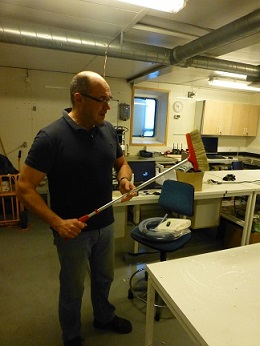
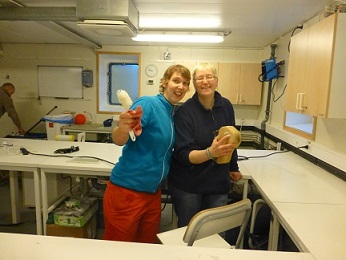
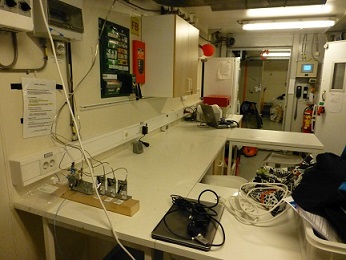
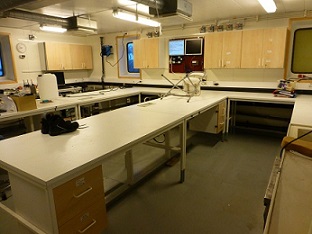
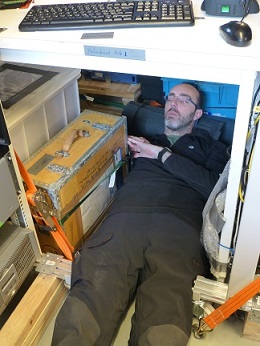 Yesterday we also started switching off most of our remaining instruments and packing everything together that will not be used during leg 2. For us, the main work was done already by packing away the stripping board several days ago, but there was still a couple of things to be rearranged in the lab, many things that have been screwed to the tables to be removed, to be packed into boxes and to be moved to the storage container. On the port side of the main lab, things will look completely different for leg 2 – Barbara, Emma and Martin have packed away all their filtration equipment, and the lab is empty and clean now. It is strange feeling today after the final cleanup in the morning: looking at the empty spaces, where only the holes in the tables tell that our equipment has been there... it feels a bit sad. It feels a bit like leaving home. We in the main lab have this feeling of it being our temporary home for the past 5 weeks. It’s not really our cabins we associate this feeling with, but the lab. For once, this is where we have spent most of our waking time (actually, I have the feeling that I have only started now to see my cabin in daylight, during most of the cruise I just went in there to immediately fall asleep and left immediately after waking up...) and we have put more effort into creating a “habitable environment for scientists” there (as Henry formulated it early in the cruise) in the lab: We had music for a good atmosphere (thanks again to Marc for even creating a special “night shift mix” for us!), even sometimes live music from the clean lab (Marcus practicing the saxophone or clarinet when waiting for an analysis to finish), a corner under a table with sleeping mats for short breaks (well, those had be originally bought as packing material and isolation for equipment, but it just turned out one could as well have a nap on them between work hours), there was the “duct tape wall”, where we put up tape pieces with funny or philosophical things that someone had said during the expedition; and we had the “mood of the day camera” which we used to take a picture every day to illustrate our respective moods (was really fun to look at it all together now in the end). And one important thing: In a way, being in the lab was like being with “the family”: there was always someone around to talk to, to help out when the work load got too heavy or when just quick help or an idea was needed, or to cheer you up or to cry with you. As you might imagine, being together in a confined space for such a long time and working really hard is not always easy, and of course we had our share of stress and tensions. But overall I have a mostly happy memories of my time onboard so far, and I am still amazed how well it worked out. And the people in the main lab (also partly including the CTD team) have really been like family to me on this trip. Some of these colleagues were already my friends before the cruise started, and I was a bit worried that working together for 6 weeks under stressful conditions might influence our friendship negatively. But the opposite happened, we have grown more together, and I can’t imagine how that cruise would have been without their support, both emotionally and from the work side. And there are other colleagues – some that I have known, but haven’t had the chance to talk to and interact much before the cruise, some that I have met now for the first time – that I got to know a lot better and really learned to appreciate on this cruise. This is not limited to the people working in and around the mainlab, but it is with them I feel this special “family” connection – since we spent so much time together, had so much fun together, were there for each other and went through so much together. And we also had similar things “to go through” on that cruise: We had similar workload at the same time, sharing both the stress of having to prepare for or to finish a station in a hurry or to wait for a station the whole night
Yesterday we also started switching off most of our remaining instruments and packing everything together that will not be used during leg 2. For us, the main work was done already by packing away the stripping board several days ago, but there was still a couple of things to be rearranged in the lab, many things that have been screwed to the tables to be removed, to be packed into boxes and to be moved to the storage container. On the port side of the main lab, things will look completely different for leg 2 – Barbara, Emma and Martin have packed away all their filtration equipment, and the lab is empty and clean now. It is strange feeling today after the final cleanup in the morning: looking at the empty spaces, where only the holes in the tables tell that our equipment has been there... it feels a bit sad. It feels a bit like leaving home. We in the main lab have this feeling of it being our temporary home for the past 5 weeks. It’s not really our cabins we associate this feeling with, but the lab. For once, this is where we have spent most of our waking time (actually, I have the feeling that I have only started now to see my cabin in daylight, during most of the cruise I just went in there to immediately fall asleep and left immediately after waking up...) and we have put more effort into creating a “habitable environment for scientists” there (as Henry formulated it early in the cruise) in the lab: We had music for a good atmosphere (thanks again to Marc for even creating a special “night shift mix” for us!), even sometimes live music from the clean lab (Marcus practicing the saxophone or clarinet when waiting for an analysis to finish), a corner under a table with sleeping mats for short breaks (well, those had be originally bought as packing material and isolation for equipment, but it just turned out one could as well have a nap on them between work hours), there was the “duct tape wall”, where we put up tape pieces with funny or philosophical things that someone had said during the expedition; and we had the “mood of the day camera” which we used to take a picture every day to illustrate our respective moods (was really fun to look at it all together now in the end). And one important thing: In a way, being in the lab was like being with “the family”: there was always someone around to talk to, to help out when the work load got too heavy or when just quick help or an idea was needed, or to cheer you up or to cry with you. As you might imagine, being together in a confined space for such a long time and working really hard is not always easy, and of course we had our share of stress and tensions. But overall I have a mostly happy memories of my time onboard so far, and I am still amazed how well it worked out. And the people in the main lab (also partly including the CTD team) have really been like family to me on this trip. Some of these colleagues were already my friends before the cruise started, and I was a bit worried that working together for 6 weeks under stressful conditions might influence our friendship negatively. But the opposite happened, we have grown more together, and I can’t imagine how that cruise would have been without their support, both emotionally and from the work side. And there are other colleagues – some that I have known, but haven’t had the chance to talk to and interact much before the cruise, some that I have met now for the first time – that I got to know a lot better and really learned to appreciate on this cruise. This is not limited to the people working in and around the mainlab, but it is with them I feel this special “family” connection – since we spent so much time together, had so much fun together, were there for each other and went through so much together. And we also had similar things “to go through” on that cruise: We had similar workload at the same time, sharing both the stress of having to prepare for or to finish a station in a hurry or to wait for a station the whole night